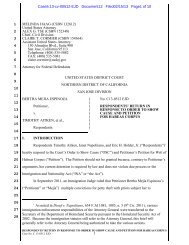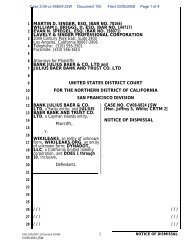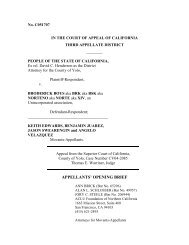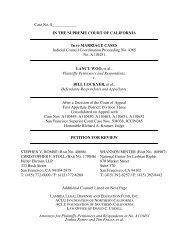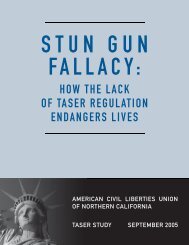Public Safety Realignment - ACLU of Northern California
Public Safety Realignment - ACLU of Northern California
Public Safety Realignment - ACLU of Northern California
- No tags were found...
You also want an ePaper? Increase the reach of your titles
YUMPU automatically turns print PDFs into web optimized ePapers that Google loves.
Counties that use this incarceration sanction are advised to do so sparingly, to gather data on its use,and to monitor its use by supervising agents. Policies should state clearly when and how severely thissanction is to be used (including length <strong>of</strong> stay). Keeping the use <strong>of</strong> “flash incarceration” in checkwill require cooperation between agencies and a shared commitment to investing in outcomes, ratherthan simply continuing a mentality some described to us as “trail ‘em, nail ‘em, and jail ‘em.”MAKING REALIGNMENT WORKJoint Planning, Implementation and AccountabilityThe first year’s realignment planning occurred quickly, with counties having only the timefrom the July enactment to the October 1 effective date to do most <strong>of</strong> their planning. Thoughnot currently explicit in the realignment legislation, it makes sense for, and the state shouldrequire, counties to submit new or revised plans for each annual budget cycle, making changes inlight <strong>of</strong> past years’ practice and additional time and thought for research and program development.The state should specify questions and plan elements that each county should consider, even if thestate does not mandate uniform adoption <strong>of</strong> all <strong>of</strong> these elements. Santa Cruz County’s plan explicitlyprovides for such ongoing implementation planning, and should serve as a model for other countiesin this respect. 140As noted above, the success <strong>of</strong> alternatives to incarceration largely depends on the ability <strong>of</strong> variousagencies to collaborate effectively in the administration <strong>of</strong> the criminal justice system. Joint planningand implementation, with close coordination and shared buy-in among probation, the sheriff, thedistrict attorney, the public defender, courts and community-based organizations will largelydetermine whether these alternatives will work. Only a handful <strong>of</strong> counties indicate such an intent orcapacity in their realignment plans.Santa Cruz County’s realignment plan, for example, describes a joint risk assessment pilot programbetween the court and probation department. 141 District attorneys and courts have an important roleto play in reducing recidivism by requesting and handing down sentences that include alternatives tojail time in cases where other forms <strong>of</strong> supervision and programming are more likely to reduce future<strong>of</strong>fenses. Validated risk and needs assessments can inform the court’s sentencing decisions if they areadministered before the sentencing phase, as is planned in Santa Cruz.In the San Francisco plan, the local community corrections partnership (LCCP) noted that the districtattorney will need to develop creative and effective sentencing approaches based on risk and needsassessments <strong>of</strong> defendants, and the district attorney is rolling out a plan to equip prosecutors with a“Recidivism Reduction Approach” to assessing sentencing options. According to the plan, the districtattorney will organize staff trainings on alternative sentencing and develop tools prosecutors can useto identify sentencing strategies most likely to reduce recidivism. The district attorney also aims to38



